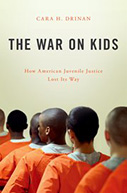The War On Kids: How American Juvenile Justice Lost Its Way

Author: Cara H. Drinan
Publisher: Oxford, UK; New York: Oxford University Press, 2018. 224p.
Reviewer: Barry C. Feld | May 2018
In 1988, the Supreme Court in Thompson v Oklahoma prohibited the death penalty for a fifteen-year-old youth convicted of murder. Among the Court’s reasons to disallow the sentence was concern about the unintended interaction of juvenile transfer statutes and adult criminal sentences. The Court opined that one statute “authorized capital punishment for murder, without setting any minimum age . . . and [another statute] quite separately, provided that 15-year-old murder defendants may be treated as adults in some circumstances.” In The War on Kids, Cara Drinan examines the subsequent three decades of interactions of waiver laws and criminal sentencing statutes, the impact of get tough policies that consigned more and younger offenders to criminal courts and increased the severity of sentences there, the Supreme Court’s recent trilogy of cases – Roper v. Simmons, Graham v. Florida, and Miller v. Alabama – that finally affirmed that “children are different,” and their implications for future juvenile and criminal justice policy reforms. She does so, in part, by personalizing and humanizing the defendants in those seminal cases and providing case studies of other youths affected by those decisions. In this slim volume (163 pages plus endnotes), she examines the plight of “kids caught in the crosshairs” (p. 5) of get tough transfer and sentencing policies that disproportionately affect children of color.
She begins Chapter 1 with the back-stories of the defendants in Graham and Miller and how they ended up serving Life Without Parole (LWOP) sentences. She uses their stories to briefly describe the arc of juvenile justice policies – the Progressive Era, the Due Process Era, the Get Tough Era, and the contemporary Kids Are Different Era. During the Get Tough Era of the 1980s and 1990s, states lowered the age of eligibility for transfer, increased the numbers of offenses excluded from juvenile court jurisdiction, and shifted discretion from judges in waiver hearings to prosecutors making charging decisions. By the beginning of the twenty-first century, more than half the states had enacted mandatory transfer provisions for serious crimes. During the same period, states also enacted more punitive sentencing laws for criminal offenders – determinate, mandatory minimum, and LWOP sentences. Although Drinan asks “how did we abandon the groundbreaking model of juvenile justice that we constructed only a little more than a century ago?,” (p. 4), she devotes only two paragraphs (pp. 22 – 23) to describe the adoption of get tough criminal sentencing laws without exploring the larger social structural context or the politics of race within which they were enacted.
In Chapter 2, Drinan explores the circumstances and characteristics of youths who face draconian sentences in criminal court. Poverty is the biggest single risk factor for successful child development and for criminal involvement. Poverty affects how their parents raise them, whether they witness or experience domestic violence, exposure to hunger and inadequate nutrition, residential instability, the safety of their communities, the quality of schools they attend, and ultimately their likelihood of justice system involvement. And children of color are three to four times more likely to grow up in poverty than their white contemporaries. In a somewhat lengthy and tangential discussion to illustrate the role of racial bias, Drinan uses the disparate impact of New York City’s “stop and frisk” policy to document how poverty and race affect children of color’s likelihood of encounters with law enforcement.
In Chapter 3, Drinan explains that certain policies – “school to prison pipeline,” transfer laws, ineffective assistance of counsel, and application of mandatory sentences to juveniles – interact and expose youths to LWOP sentences. The “school to prison pipeline” reflects the confluence of get tough policies that increasingly rely on exclusionary sanctions and disproportionately affect children of color. Heightened surveillance and security measures, the ubiquitous presence of police – School Resource Officers (SROs) – and zero-tolerance policies toward criminal and school misconduct result in increased referrals of youths to juvenile courts. An important factor that Drinan does not address is the lower Fourth Amendment standard – reasonable suspicion – that governs school searches and results in some evidence that is admissible in juvenile courts that would not be allowed under the Fourth Amendment’s higher probable cause standard. Moreover, the connection between the “school-to-prison” pipeline and her primary focus on transfer and criminal sentencing seems somewhat tenuous. Although transfer to criminal court is the most consequential decision affecting youths, increasingly it occurs automatically on the basis of the offense charged or the prosecutor’s exercise of discretion, rather than in a judicial hearing that considers characteristics of the offender. The interaction of transfer laws and criminal sentencing statutes is exacerbated by the inadequate quality of legal representation youths receive. In the half century since the Court granted juvenile and criminal defendants a constitutional right to counsel, the right is honored more in the breach than in the observance. Penurious politicians who want to get tough on crime and avoid coddling criminals have shirked their responsibility to adequately fund public defenders’ offices and undermined the quality of justice. The Court in Graham emphasized that youth’s immaturity and developmental incompetence increased their risks of conviction because “[t]hey are less likely than adults to work effectively with their lawyers to aid in their defense.” Finally, mandatory minimum sentencing statutes preclude consideration of the mitigating aspects of youth and their reduced culpability.
Chapter 4 examines the experiences of youths incarcerated in the juvenile and criminal justice systems. From their inception, juvenile institutions have been “schools for crime” that disproportionately confine poor and minority youths. Unfortunately, Drinan uses “detention” interchangeably to refer both to pretrial detention and post-adjudication commitment to correctional facilities like training schools. Although her critiques of each are valid, it is sometimes difficult to determine to which she is referring. Progressive reformers created juvenile courts to keep youths out of the criminal justice system, jails, and prisons. Drinan describes youths’ vulnerability to physical violence, sexual assault, and numbing monotony in prisons designed for adults. Prisons are developmentally inappropriate places for youths to form an identity, acquire social skills, or make a successful transition to adulthood. Imprisonment confounds these tasks where a criminal identity can be self-protective, peer relationships entail schooling for crime, decision-making authority is stripped away, and guards focus on security rather than positive transformations.
In Chapter 5, Drinan analyzes the Court’s decisions in Roper, Graham, and Miller that reviewed states’ get tough laws that ignored adolescents’ reduced culpability. In light of their unalloyed punitiveness and racial and penal disproportionality, the Court asserted that “enough is enough” and recognized that “children are different.” In 2005, Roper prohibited states from executing offenders for murder committed prior to eighteen years of age. The Justices concluded that youths’ immature judgment and lack of self-control, susceptibility to negative peer influence, and transitory personalities reduced their culpability and precluded the most severe sentence. Graham extended Roper’s diminished responsibility rationale and prohibited states from imposing LWOP sentences for non-homicide offenses. Miller extended Roper and Graham’s diminished responsibility rationale and barred mandatory LWOP sentences for youths convicted of murder. Miller required judges to make individualized culpability assessments and to weigh youthfulness as a mitigating factor. Despite the Court’s repeated assertions that “children are different,” Graham provided non-homicide offenders very limited relief – “some meaningful opportunity to obtain release” – without requiring either rehabilitative services or eventual freedom. Miller required a judge to make an individualized assessment of a juvenile murderer’s culpability but did not give legislators or judges practical guidance how to conduct such culpability hearings, how to weight youthfulness as a mitigating factor, and did not preclude an LWOP sentence. As Drinan documents, state courts and legislatures have struggled to implement the Court’s “jurisprudence of youth” when sentencing them as adults. Although Drinan makes passing references to developmental psychology and “brain science,” there is no analysis of the psychological or neuroscience research on which the Court relied to find youths’ diminished criminal responsibility.
Chapter 6 presents three case studies of youths who earlier had received LWOP sentences as juveniles and the impact of Miller’s retroactive application for their lives. In one case, Miller prompted a serious reconsideration of the juvenile’s claim of wrongful conviction after three decades of imprisonment and led to his release. In the second case, the youth had served more than three decades of his LWOP sentence, and was able to demonstrate to the parole board that he had matured and changed, and he received parole. In the third case and with similar facts to the second, the youth had served more than thirty years, transformed himself into a thoughtful college-educated adult, and was denied parole. From these analyses, Drinan draws a number of policy prescriptions for parole boards to remedy the “messy, unpredictable, and unfair” application of Miller.
In Chapter 7, Drinan looks to the future – “The War for Kids” – builds on the Court’s “jurisprudence of youth,” and describes reforms necessary to implement it. She reviews some states’ positive responses to Miller and decries others’ evasions based on technical interpretations of the decision. While Miller addressed LWOP sentences, many other juveniles are serving lengthy term-of-years sentences that greatly exceed their life expectancies, and she notes states’ inconsistent responses to their claims. She argues that Miller’s prohibition of mandatory LWOP should also preclude other types of mandatory decisions – automatic transfer, mandatory minimum sentences, and the like – that preclude individualized consideration of the offender. Although she notes a modest legislative trend away from juvenile LWOPs, she criticizes states’ failure to implement more fully youthfulness as a mitigating factor in sentencing youths as adults. She also advocates for a return to more rehabilitative dispositions for youths sentenced in juvenile court. She touts the Missouri Model of youth corrections – small community-based facilities, an emphasis on peer- and staff-team treatment, education and vocational training, family involvement, and intensive aftercare. Despite her enthusiasm, however, the National Academy of Sciences, Reforming Juvenile Justice 422 (2013), concluded that “there is no credible scientific evidence demonstrating the effectiveness of this approach . . . [T]he little research that has been conducted on the Missouri model falls far short of these [rigorous evidence-based] standards.”
In her conclusion, Drinan questions whether there is the political will to implement needed reforms. She attributes the Get Tough Era to emotional appeals by fear-mongering politicians and argues that “[a] war for kids on an emotional front, then, must begin by humanizing the image of someone, particularly a child, who breaks the law.” In her case studies and vignettes of young offenders, she has successfully humanized them. Ultimately, she concludes that juvenile justice policy and practice should be guided by the single dictum – what would be acceptable if this were my child?
This is a well-written book that conveys the harsh reality of criminal justice practices and legal doctrines in a way accessible to non-lawyers and the broader public. She has achieved her aim of describing the draconian sentences that states impose on immature youths and their punitive consequences, humanized the young offenders caught in the cross-hairs of harsh waiver/sentencing laws, and provided some directions for improvement. Although she identifies some modest doctrinal reforms for future decisions, the Supreme Court has reached the limit of what it can accomplish through the Eighth Amendment to ameliorate harsh sentences for children. The responsibility now rests with state legislatures. It will take political courage for legislators to enact laws that recognize young offenders’ diminished responsibility. It will take bravery when a political opponent may charge a legislator with being soft on crime. But the legislators who enacted unjust, disproportionate, and counterproductive transfer and sentencing law must undo the damage they caused and adopt sensible laws for children. Is there political will to do so when politicians and the public view juvenile and criminal courts’ clientele – poor and minority youths – as “other people’s children” and not their own?
Barry Feld, Centennial Professor of Law Emeritus, University of Minnesota, School of Law


